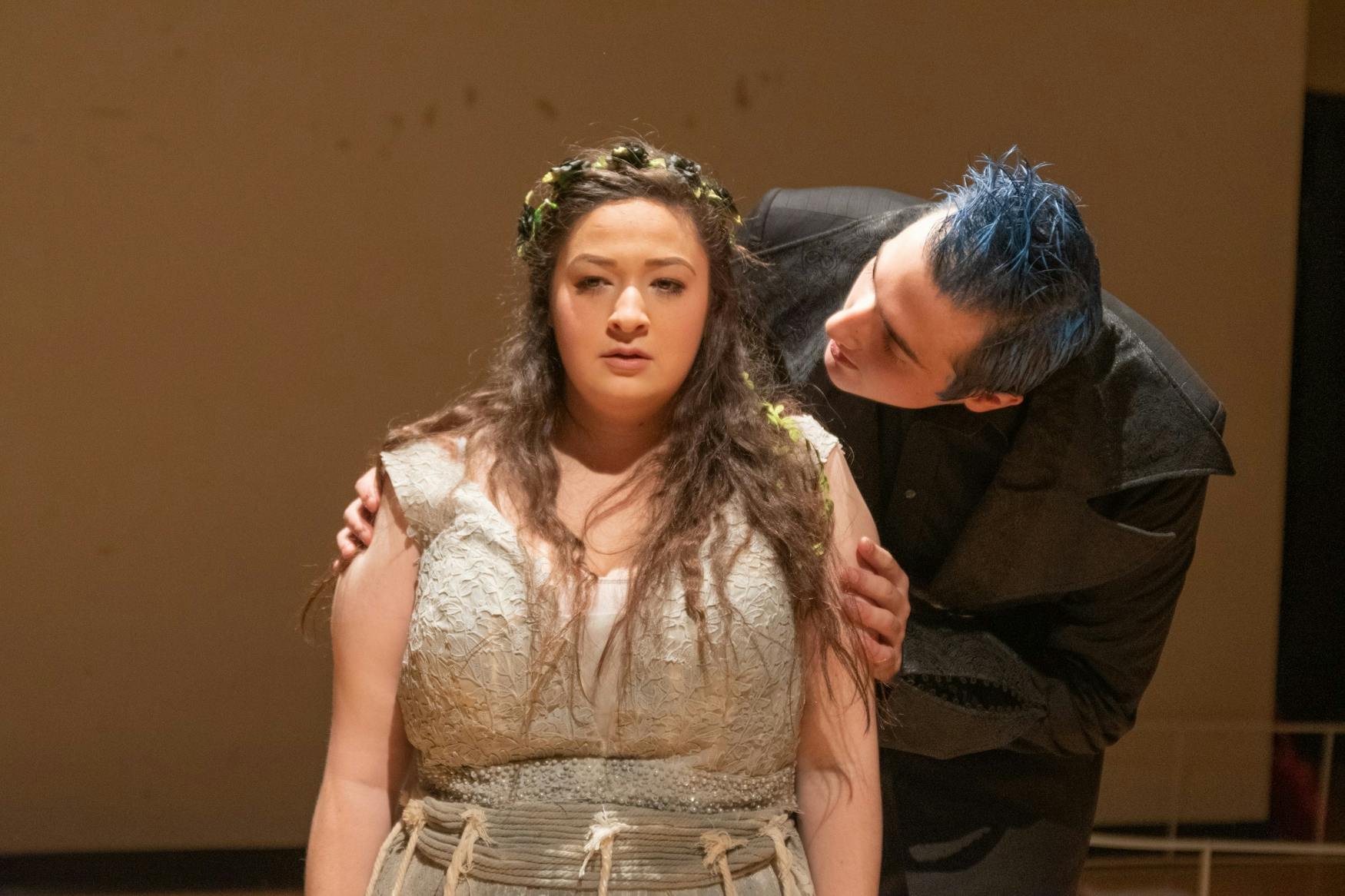‘Eurydice’ challenges the role of gender in storytelling
The damsel in distress, the cold villainess and the femme fatale: these are all popular tropes that female characters tend to fall into. Rarely do we see a nuanced role for women because most stories are not told by women. This made Eurydice a breath of fresh air.
Theater Arts majors Haia R’nana Bchiri ’20 and Rachel Greene ’20 have been working to reclaim the female voices in Western drama. There was a particular intrigue for the dichotomy in Ancient Greek theater, where women in plays and lore were seen as strong and capable while Athenian women were not allowed to perform and could not portray these roles. The two decided to bring Eurydice by Sarah Ruhl to Brandeis with Bchiri as the director and Greene as the titular character. The original Greek myth focuses on Hades, Lord of the Underworld, kidnapping Eurydice. Her lover, Orpheus, must journey to the Underworld and rescue her. Usually, the story of Orpheus and Eurydice is told from the perspective of Orpheus. While Orpheus still played an important role in the play, most of the spotlight was on Eurydice and her relationship with her father (Zach Garrity ’20). One of the major changes from the original myth in the Ruhl play was the fact that Eurydice possessed a lot of agency. Her decisions drove the plot of the play.
The play started in a rather unusual way. The audience was asked to stand outside the Laurie Theater. Once the play commenced, instead of entering the theater, they were led to the first scene, which happened in front of the Laurie Theater. Here, Orpheus proposed to Eurydice. The scene was heartwarming. The crowd cooed in response to the tender scene. Once it was over, the audience was brought to the Merrick Theater, where they sat cross legged in front of tea candles. This toying with space was unique and added to the performance’s memorability. “I found that audiences connected with the material more when they were completely immersed in the world of the show,” said Bchiri. “I believe that the message of this show is especially vital right now and I wanted to make sure audiences felt that urgency and connection. Additionally, I think there is something about magical realism that wants to be immersive in order to truly create a sense of a different world into which the audience has stepped.”

CHORUS AND CAST: Throughout the show, a group of nameless stones moved around to interact with the actors and the audiance.
All of the actors gave strong performances. Bchiri did a great job at finding the right actors for each role: “I was looking particularly for actors who would give a great deal to their characters while also being supportive collaborators, since this truly is an ensemble piece.” Greene, who has been in countless Brandeis productions, was convincing as Eurydice. She evoked sadness, humor, confusion and joy. The villain, billed Interesting Man/Lord of the Underworld and played by Garrett Tordo ’21, gave a unique performance. The character was psychotic, which bred a humor that reminded me of Heath Ledger’s Joker in “The Dark Knight.” There were scenes where he invaded Eurydice’s personal space, hovering over her and touching her without consent. This made both Eurydice and the audience uncomfortable. He really nailed the idea of being dangerous in an amicable way.
I liked the addition of the Stones (Micaela Grimes ’22, Alaysia Penso ‘23 and Grace Ahlin ’23), a female chorus that appeared during Eurydice’s time in the underworld. When they were not yelling at the leads, they darted around the room on their haunches, moving objects and staring at the audience. Since they were in such close proximity to the audience, there were occasions when they yelled too much. At one point, Eurydice screamed at them to shut up and I couldn’t agree more with her.
The costume design for this show, executed by Kat Lawrence ’21, was breathtaking. Eurydice’s sparkling white wedding dress and the white dresses for the Stones, which were both feminine and punk, stood out in particular. I also liked Opheus’s baby blue suit. It was fitting considering how emotional and delicate nature of the character.
The play explored interesting concepts. Once Eurydice entered the Underworld, she could not speak English or understand human concepts. Her father had to reteach her words. This idea played with the Sapir-Whorf hypothesis, which explains that people cannot understand concepts if they do not have the language to label the concept. Eurydice did not understand what a father was because the idea of family and love did not exist in the Underworld. This aspect of the play teaches the audience that change cannot occur without knowledge. Social justice movements, like the Me Too movement, could not occur if informed people did not use their knowledge to enlighten others of the problems with the status quo.
Water also played an important role in the play. “Water [is] the thing Eurydice keeps requesting of the men around her but none listen or oblige,” Bchiri says. “[It is] symbolic of the toxic masculinity that keeps Eurydice in this cycle even though she strives for more agency in this iteration of her story. Water also is multifaceted: it’s healing and life-sustaining, but also has great power and potential for destruction. Nevertheless, it is often taken for granted.”
A lot of work was put into Eurydice. It was great to see a story that was female focused and gave its heroine agency. Every asset of the play — from the casting, acting, set design and costumes — were carefully tailored to tell a powerful tale.



Please note All comments are eligible for publication in The Justice.